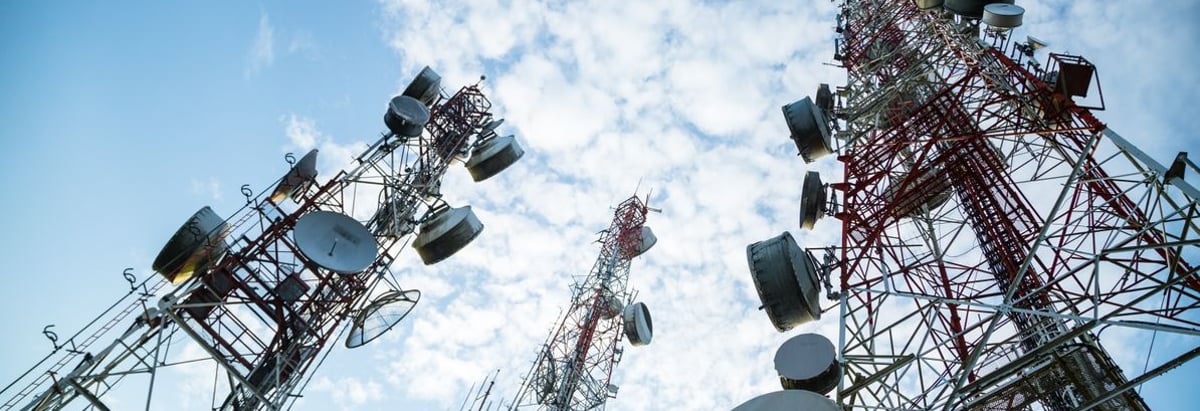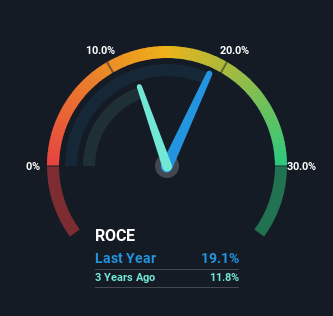- India
- /
- Telecom Services and Carriers
- /
- NSEI:INDUSTOWER
Indus Towers (NSE:INDUSTOWER) Is Experiencing Growth In Returns On Capital

If you're not sure where to start when looking for the next multi-bagger, there are a few key trends you should keep an eye out for. In a perfect world, we'd like to see a company investing more capital into its business and ideally the returns earned from that capital are also increasing. Ultimately, this demonstrates that it's a business that is reinvesting profits at increasing rates of return. So when we looked at Indus Towers (NSE:INDUSTOWER) and its trend of ROCE, we really liked what we saw.
What Is Return On Capital Employed (ROCE)?
Just to clarify if you're unsure, ROCE is a metric for evaluating how much pre-tax income (in percentage terms) a company earns on the capital invested in its business. The formula for this calculation on Indus Towers is:
Return on Capital Employed = Earnings Before Interest and Tax (EBIT) ÷ (Total Assets - Current Liabilities)
0.19 = ₹84b ÷ (₹530b - ₹93b) (Based on the trailing twelve months to December 2023).
So, Indus Towers has an ROCE of 19%. In absolute terms, that's a pretty normal return, and it's somewhat close to the Telecom industry average of 16%.
View our latest analysis for Indus Towers

In the above chart we have measured Indus Towers' prior ROCE against its prior performance, but the future is arguably more important. If you're interested, you can view the analysts predictions in our free analyst report for Indus Towers .
The Trend Of ROCE
We like the trends that we're seeing from Indus Towers. The numbers show that in the last five years, the returns generated on capital employed have grown considerably to 19%. Basically the business is earning more per dollar of capital invested and in addition to that, 196% more capital is being employed now too. So we're very much inspired by what we're seeing at Indus Towers thanks to its ability to profitably reinvest capital.
The Bottom Line
In summary, it's great to see that Indus Towers can compound returns by consistently reinvesting capital at increasing rates of return, because these are some of the key ingredients of those highly sought after multi-baggers. Since the stock has returned a solid 70% to shareholders over the last five years, it's fair to say investors are beginning to recognize these changes. So given the stock has proven it has promising trends, it's worth researching the company further to see if these trends are likely to persist.
While Indus Towers looks impressive, no company is worth an infinite price. The intrinsic value infographic for INDUSTOWER helps visualize whether it is currently trading for a fair price.
While Indus Towers isn't earning the highest return, check out this free list of companies that are earning high returns on equity with solid balance sheets.
New: AI Stock Screener & Alerts
Our new AI Stock Screener scans the market every day to uncover opportunities.
• Dividend Powerhouses (3%+ Yield)
• Undervalued Small Caps with Insider Buying
• High growth Tech and AI Companies
Or build your own from over 50 metrics.
Have feedback on this article? Concerned about the content? Get in touch with us directly. Alternatively, email editorial-team (at) simplywallst.com.
This article by Simply Wall St is general in nature. We provide commentary based on historical data and analyst forecasts only using an unbiased methodology and our articles are not intended to be financial advice. It does not constitute a recommendation to buy or sell any stock, and does not take account of your objectives, or your financial situation. We aim to bring you long-term focused analysis driven by fundamental data. Note that our analysis may not factor in the latest price-sensitive company announcements or qualitative material. Simply Wall St has no position in any stocks mentioned.
About NSEI:INDUSTOWER
Indus Towers
A telecom infrastructure company, engages in the operation and maintenance of wireless communication towers and related infrastructures for various telecom service providers in India.
Outstanding track record with excellent balance sheet.
Similar Companies
Market Insights
Community Narratives




